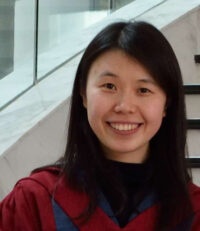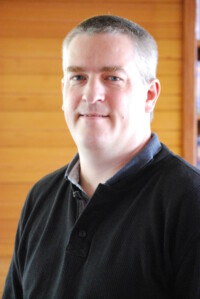-

Seth Hutchinson
University of Illinois at Urbana-Champaign
Seth Hutchinson is Professor and KUKA Chair for Robotics in the School of Interactive Computing at the Georgia Institute of Technology, where he also serves as Associate Director of the Institute for Robotics and Intelligent Machines. His research in robotics spans the areas of planning, sensing, and control. He has published more than 200 papers on these topics, and is coauthor of the books “Principles of Robot Motion: Theory, Algorithms, and Implementations,” published by MIT Press, and “Robot Modeling and Control,” published by Wiley. Hutchinson currently serves on the editorial board of the International Journal of Robotics Research and chairs the steering committee of the IEEE Robotics and Automation Letters. He was Founding Editor-in-Chief of the IEEE Robotics and Automation Society’s Conference Editorial Board (2006-2008) and Editor-in-Chief of the IEEE Transaction on Robotics (2008-2013). Hutchinson is an Emeritus Professor of Electrical and Computer Engineering at the University of Illinois at Urbana-Champaign, where he was Professor of ECE until 2018, serving as Associate Head for Undergraduate Affairs from 2001 to 2007. He received his Ph.D. from Purdue University in 1988. Hutchinson is Fellow of the IEEE.
-

José Neira Parra
Universidad de Zaragoza
José is a full professor at the Computer Science and Systems Engineering dept, Universidad de Zaragoza, Spain. José holds a degree in Computer Science Engineering from the Universidad de Los Andes in Colombia (1986), and a PhD in Computer Science from the University of Zaragoza (1993). He was Assistant Lecturer until 1999, Associate Professor until 2010, when he became Full Professor in Computer Science. José teaches courses in Computer Programming, Computer Vision, Compiler Theory, Robotics and Machine Learning, in several degrees at the University of Zaragoza and also frequently as invited lecturer in many universities, research centers and conferences throughout the world. He has been invited researcher at the Massachusetts Institute of Technology, the University of Oxford, Imperial College London, the Technical University of Munich, and the Instituto Superior Tecnico of Lisbon.
José has served as associate editor for the IEEE Transactions on Robotics, and has been invited editor for Robotics and Autonomous Systems, the Journal of Field Robotics, Autonomous Robots, and the IEEE Transactions on Robotics. José also is also involved as expert in the evaluation of FP7 and H2020 Research and Innovation programs of the European Commission, as well as the European Research Council (ERC) grants programs.
-

Laura Leal-Taixé
Technical University of Munich
Prof. Laura Leal-Taixé is leading the Dynamic Vision and Learning group at the Technical University of Munich, Germany. She received her Bachelor and Master degrees in Telecommunications Engineering from the Technical University of Catalonia (UPC), Barcelona. She did her Master Thesis at Northeastern University, Boston, USA and received her PhD degree (Dr.-Ing.) from the Leibniz University Hannover, Germany. During her PhD she did a one-year visit at the Vision Lab at the University of Michigan, USA. She also spent two years as a postdoc at the Institute of Geodesy and Photogrammetry of ETH Zurich, Switzerland and one year at the Technical University of Munich. In 2017, she won the Sofja Kovalevskaja Award of 1.65 million euros from the prestigious Humboldt Foundation for her project “socialMaps”. Her research interests are dynamic scene understanding, in particular multiple object tracking and segmentation, as well as machine learning for video analysis. -

Tarek Hamel
University of Nice Cote d’Azur
Tarek Hamel is Professor at the University of Nice Cote d’Azur since 2003. He received his PhD degree in Robotics from the University of Technology of Compiègne (UTC), France, in 1996. After two years as a research assistant at the UTC, he joined the Centre d’Etudes de Mécanique d’Ile de France in 1997 as an associate professor. His research interests include nonlinear control theory, estimation and vision-based control with applications to Unmanned Aerial Vehicles. He is senior member of the Institut Universitaire de France. He served as Associate Editor for IEEE Transactions on Robotics and for Control Engineering Practice.
-

Silvère Bonnabel
Mines ParisTech
Silvère Bonnabel received the engineering and Ph.D. degree in mathematics and control from Mines ParisTech, in 2004 and 2007 and held a Postdoctoral Position at University of Liège in 2008. He is currently Professor at Mines ParisTech, in the Centre for Robotics, and was a Visiting Fellow at the University of Cambridge in 2017. He was awarded the IEEE/SEE Glavieux Prize in 2015. He serves an Associate Editor for Systems and Control Letters. His research includes nonlinear state estimation and its applications to navigation, tracking, and SLAM. He currently works on various industrial applications, such as inertial navigation and self-driving cars with the group Safran, radar tracking with the group Thales, and pedestrian localization with the start-up FeetMe.
-

Qi Wu
University of Adelaide
Dr. Qi Wu is a lecturer in the University of Adelaide. Before that, he was a postdoc in the Australia Centre for Robotic Vision (ACRV) and the Australia Centre for Visual Technologies (ACVT) in the University of Adelaide. He obtained his PhD degree in 2015 and MSc degree in 2011, in Computer Science from the University of Bath, United Kingdom. His research interests are mainly in Computer Vision and Machine Learning. Currently, he is working on the vision-to-language problem and he is especially an expert in the area of Image Captioning and Visual Question Answering (VQA). He has published several papers in prestigious conferences and journals, such as TPAMI, CVPR, ICCV, ECCV, IJCAI and AAAI.
-

Miaomiao Liu
Australian National University
Dr Miaomiao Liu is a Lecturer and an ARC DECRA Fellow in the Computer Vision and Robotics Group at ANU. She was a Research Scientist at Data61/CSIRO from 2016-2018. Prior to that she was a postdoctoral research fellow and researcher in NICTA. She received her PhD degree in November 2012 from the University of Hong Kong. Her research interests include 3D vision, 3D reconstruction and 3D Scene Modeling and Understanding. She joined the Centre as an Associate Investigator in July 2018.
-

Niko Suenderhauf
Queensland University of Technology
Niko received his PhD from Chemnitz University of Technology, Germany in 2012. In his thesis, Niko focused on robust factor graph based models for SLAM and general probabilistic estimation problems and developed the concept of switchable constraints. After his PhD, his research interests have been in the area of robust place recognition in changing environments. After two years postdocing in Chemnitz, Niko joined QUT as a Research Fellow in March 2014. His research is continuing robust visual representations for place recognition under extreme appearance changes and will address this problem by utilising and extending various deep learning techniques. In early 2017, Niko was appointed as Lecturer in the Robotics and Autonomous Systems Discipline at QUT. In November 2017, he joined the Centre Leadership Team through his appointment as a Chief Investigator.
-

Peter Corke
Queensland University of Technology
Peter Corke is a distinguished Professor at the Queensland University of Technology and director of the ARC Centre of Excellence for Robotic Vision in Australia. Previously he was a Senior Principal Research Scientist at the CSIRO ICT Centre where he founded and led the Autonomous Systems laboratory. He is a Fellow of the IEEE, the Australian Academy of Technology and Engineering (ATSE) and Senior Fellow of the Higher Education Academy (HEA). He was the Editor-in-Chief of the IEEE Robotics and Automation magazine; founding editor of the Journal of Field Robotics; member of the editorial board of the International Journal of Robotics Research, and the Springer STAR series. He has over 500 publications in the field, a h-index of 63 and over 20,000 citations. Peter has held visiting positions at the University of Pennsylvania, University of Illinois at Urbana-Champaign, Carnegie-Mellon University Robotics Institute, and Oxford University. Peter was named the 2017 Australian University Teacher of the Year by the Australian Government’s Department of Education and Training. QUT awarded the title of Distinguished Professor recognising his truly outstanding achievements in the emerging field of Robotics.
-

Tom Drummond
Monash University
Professor Drummond is a Chief Investigator based at Monash. He studied a BA in mathematics at the University of Cambridge. In 1989 he emigrated to Australia and worked for CSIRO in Melbourne for four years before moving to Perth for his PhD in Computer Science at Curtin University. In 1998 he returned to Cambridge as a post-doctoral Research Associate and in 1991 was appointed as a University Lecturer. In 2010 he returned to Melbourne and took up a Professorship at Monash University. His research is principally in the field of real-time computer vision (ie processing of information from a video camera in a computer in real-time typically at frame rate), machine learning and robust methods. These have applications in augmented reality, robotics, assistive technologies for visually impaired users as well as medical imaging.
-

Ian Reid
University of Adelaide
Ian Reid is an Australian Laureate Fellow, Fellow of the Australian Academy of Technological Sciences and Engineering (ATSE), former Rhodes Scholar, and Professor of Computer Science at the University of Adelaide. He is the Centre’s Deputy Director, University of Adelaide Node Leader and leader of the Semantic Representations research program. His research interests range across computer vision and are currently focused on life-long visual learning, and developing high-level representations for image and video understanding, especially those that can be computed and queried sufficiently rapidly to enable real-time robotic decision making and control. He has previous published widely in areas such as active vision, visual SLAM, visual geometry, human motion capture and intelligent visual surveillance. He has published over 293 papers on these topics in major journals and refereed conferences, has more than 16,000 citations and a h-index of 65. He is a member of the Australian Academy of Science (AAS) National Committee for Information and Communication Sciences, Interim co-chair for the AAS Future of Autonomous Systems, and General Chair for the 14th Asian Conference on Computer Vision (ACCV) to be held in Perth, Australia in December 2018. He has previously served on the editorial boards of IEEE T-PAMI, Computer Vision and Image Understanding, and Image and Vision Computing Journal, and has led a number of EU, UK and Australian Research Council sponsored research projects. He was the driving force behind the Centre’s successful LIEF (Linkage Infrastructure Equipment and Facilities) grant awarded by the Australian Research Council in 2016 for a new deep learning supercomputer to power the Centre needs to train deeper and larger models and to handle large numbers of parameters and big data.
-

Ben Harwood
Monash University
Ben completed undergraduate studies in Computer Science and Mechatronics Engineering at Monash University before commencing a PhD in Computer Systems Engineering.
Ben’s research was principally focused on efficient algorithms for processing high dimensional big data. This research has applications across a broad range of tasks from extracting information out of video streams, to finding meaningful connections between statements in a large corpus.
Ben has submitted his PhD for examination in 2018 and is now a Research Fellow with the Centre.











